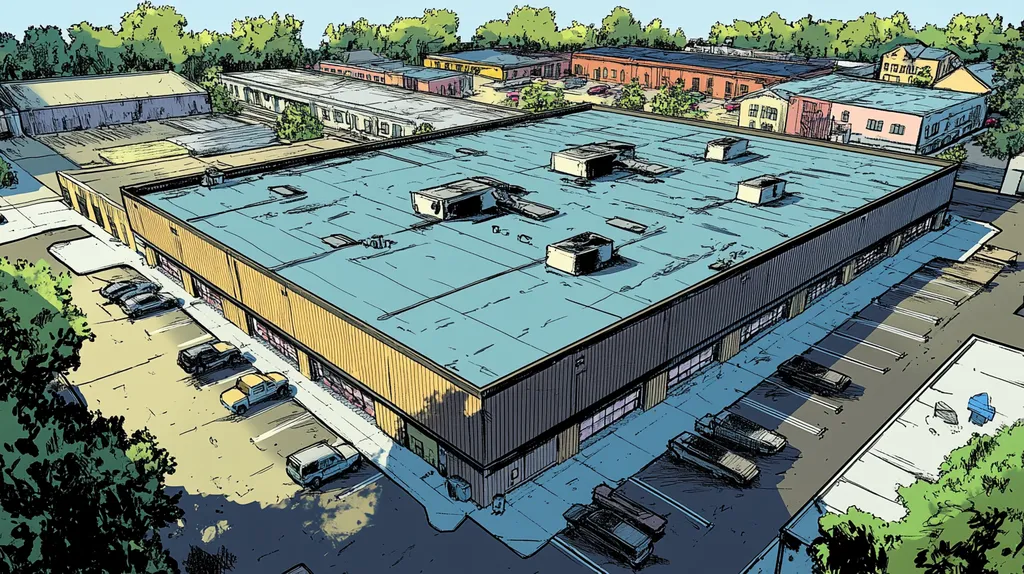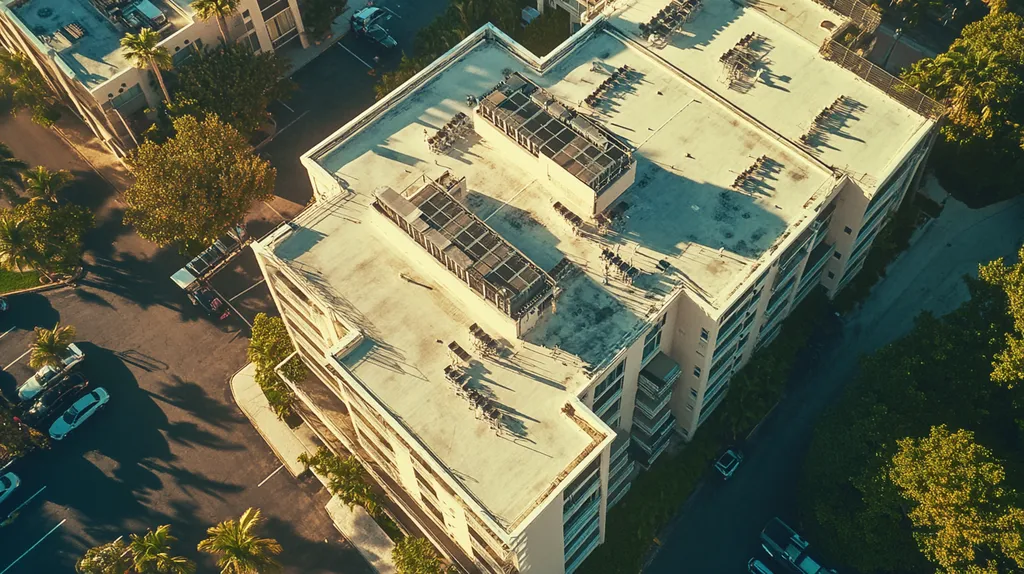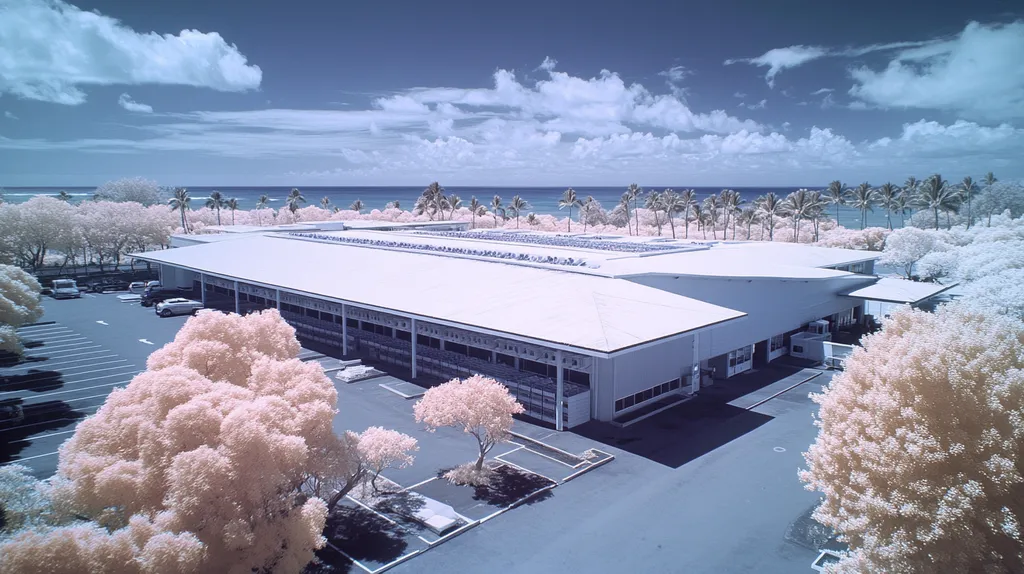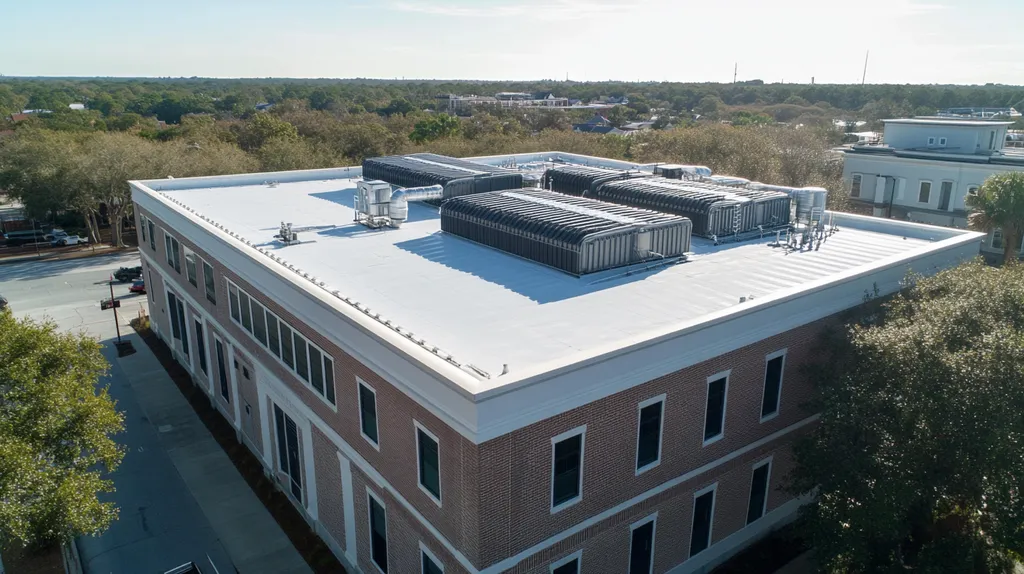Welcome to today’s Battle Royale featuring two roofing heavyweights: “TPO” in the east corner versus “PVC” in the west!
Tonight’s showdown pits these contenders against each other across six punishing rounds designed to test every aspect of their performance for Roof Slope on Commercial Coatings.
At stake? Millions in potential costs, decades of building protection, and the critical performance demands of modern commercial and industrial facilities.
Our professional judging panel will evaluate each round on technical merit, real-world performance, and value delivery. After all six rounds, we’ll declare our ultimate champion.
Ladies and gentlemen, facility managers and building owners… it’s time to rumble!
ROUND 1: INITIAL COSTS & INSTALLATION
When it comes to commercial roofing, the wrong choice between TPO and PVC can turn a six-figure investment into a million-dollar migraine. With material costs skyrocketing and skilled labor increasingly scarce, the stakes have never been higher. The slope factor adds another layer of complexity – what works perfectly on a flat surface might become a maintenance nightmare on an incline.
Material Expenses
TPO membranes typically cost 15-30% less than their PVC counterparts upfront, making them an attractive option for budget-conscious property owners. However, the initial price tag tells only part of the story, especially when roof slope enters the equation.
The appropriate roof coating can prevent UV damage, avoid water intrusion, and even lower roof temperatures by up to 50°F, dramatically extending membrane life regardless of material choice. (source: Unicoat Industrial Roofing)
PVC’s higher cost comes with premium chemical resistance and better weathering properties, particularly crucial for sloped applications where water exposure is more concentrated. This enhanced durability often translates to fewer coating applications over time.
While TPO offers substantial upfront savings, PVC’s superior performance characteristics on sloped surfaces narrow the gap. Still, TPO claims the “ADVANTAGE” in pure material costs.
Installation Complexity
TPO installation resembles a well-choreographed dance – straightforward steps that most experienced crews can execute efficiently. The material’s lighter weight and more flexible nature make it particularly manageable on slopes, reducing installation time and crew fatigue.
PVC installations demand more technical expertise, especially around seam welding and flash points. On sloped surfaces, these complexity factors multiply, requiring additional safety measures and specialized equipment.
The learning curve for TPO installation is significantly shorter, leading to fewer contractor errors and faster project completion. This difference becomes even more pronounced as roof pitch increases.
TPO’s simpler installation requirements earn it a clear “ADVANTAGE” in this category, particularly when factoring in slope considerations.
Project Timeline
Speed matters in commercial roofing – every day of installation means potential disruption to business operations. TPO projects typically wrap up 20-30% faster than comparable PVC installations, primarily due to simpler welding requirements and easier material handling.
PVC installation times balloon further on sloped surfaces, where precise seam alignment becomes more challenging. Additional curing times for certain adhesives and more complex quality control procedures also extend the timeline.
Weather sensitivity during installation affects both materials, but TPO’s faster installation window reduces exposure to potential weather delays. This advantage becomes critical during unpredictable weather seasons.
With consistently faster completion times across all slope conditions, TPO claims the “ADVANTAGE” in project timeline efficiency.
ROUND 1 WINNER: TPO
ROUND 2: DURABILITY & LIFESPAN
In the high-stakes world of commercial roofing, durability isn’t just about surviving – it’s about thriving under brutal conditions for decades. With replacement costs routinely hitting seven figures, the wrong material choice can transform a roof from an asset into a liability. The slope factor becomes a critical multiplier, dramatically affecting how these materials perform over time.
Physical Resilience Testing
TPO membranes show impressive initial strength, maintaining flexibility even under extreme temperature variations. However, their performance can degrade significantly faster on steeper slopes where UV exposure is more direct and water sheeting is more aggressive.
When it comes to urethane coatings over TPO, they deliver exceptional tensile strength and flexibility, helping protect the base membrane. Their UV resistance and ability to handle expansion make them particularly valuable for sloped applications. (source: MHI Roofing)
PVC demonstrates superior physical resilience, particularly in high-traffic areas and under sustained environmental stress. Its molecular structure provides inherent protection against UV degradation and chemical exposure, advantages that become more pronounced as slope increases.
ADVANTAGE: PVC edges out TPO in long-term physical resilience, especially on steeper pitches.
Weather Resistance Performance
TPO’s weather resistance varies significantly by manufacturer and thickness. While newer formulations show improved performance, prolonged exposure to intense sunlight and heat on sloped surfaces can accelerate degradation.
Water shedding becomes increasingly critical as slope increases, and TPO’s seam vulnerability can create weak points. These areas require more frequent inspection and maintenance to prevent premature failure.
PVC shines in weather resistance, with superior performance in high-heat and high-moisture environments. Its hot-air welded seams create monolithic surfaces that maintain integrity even under aggressive water flow on steeper slopes.
ADVANTAGE: PVC demonstrates clear superiority in weather resistance across all slope conditions.
Maintenance Requirements
TPO systems typically require more frequent inspections and maintenance, particularly on slopes where wear patterns become more pronounced. Seam inspections become critical after the first five years, with potential resealing needed around the decade mark.
The maintenance burden increases significantly with slope, as gravity-driven stress concentrates along seams and attachment points. This can lead to more frequent coating applications and repairs.
PVC’s inherent durability translates to lower maintenance requirements throughout its lifespan. Its superior chemical resistance and seam strength mean fewer interventions are needed, even on challenging slopes.
ADVANTAGE: PVC wins with significantly lower maintenance demands across all slope configurations.
ROUND 2 WINNER: PVC
ROUND 3: PERFORMANCE FACTORS
In the high-stakes world of commercial roofing, performance factors can mean the difference between a roof that lasts decades and one that becomes a money pit within years. With energy costs soaring and extreme weather events increasing, the stakes have never been higher. Understanding how slope affects coating performance isn’t just about preventing leaks – it’s about protecting million-dollar investments.
Energy Performance
TPO’s highly reflective surface excels in energy efficiency on flat and low-slope applications, dramatically reducing cooling costs. However, this advantage diminishes as slope increases, with steeper pitches reducing the membrane’s ability to reflect sunlight effectively.
Commercial roof coatings can significantly enhance UV protection and reduce heat transfer, with properly applied solutions reflecting up to 90% of harmful rays and lowering roof temperatures substantially. (source: SmartSeal)
PVC maintains consistent performance across various slopes, with its chemical composition providing natural heat resistance. While initially less reflective than TPO, PVC’s reflectivity remains more stable over time, particularly on steeper slopes where UV exposure is more intense.
ADVANTAGE: TPO edges out PVC in overall energy performance, though the gap narrows significantly on steeper slopes.
Water Management
TPO struggles with water management on minimal slopes, where its seam vulnerability becomes a critical weakness. Standing water can accelerate membrane degradation, particularly around joints and transitions.
As slope increases, TPO’s performance improves, but challenges remain around seam integrity and water channeling. The material’s tendency to expand and contract can create potential water entry points, especially on complex roof geometries.
PVC’s superior seam strength and chemical resistance make it exceptionally effective at water management across all slopes. Its hot-air welded seams create a monolithic surface that maintains watertight integrity even under aggressive water flow conditions.
ADVANTAGE: PVC demonstrates clear superiority in water management capabilities.
Chemical Resistance
TPO offers decent chemical resistance on flat surfaces but becomes more vulnerable as slope increases. The combination of gravitational stress and chemical exposure can accelerate wear patterns, particularly around mechanical systems and exhaust vents.
On steeper slopes, TPO’s chemical resistance becomes more critical as exposure patterns change. Areas where chemicals might pool or channel require additional attention and more frequent maintenance inspections.
PVC’s inherent chemical resistance remains consistent regardless of slope, providing superior protection against industrial emissions, acid rain, and other aggressive substances. This advantage becomes particularly valuable on complex roof designs where chemical exposure patterns are less predictable.
ADVANTAGE: PVC claims a decisive victory in chemical resistance across all slope configurations.
ROUND 3 WINNER: PVC
ROUND 4: MAINTENANCE REQUIREMENTS
In commercial roofing, maintenance missteps can transform a million-dollar investment into a bottomless money pit. The slope factor dramatically affects how membranes age, weather, and perform over time. Low-slope commercial roofs, defined as those with a pitch of 3:12 or less, present unique maintenance challenges that can make or break long-term performance. (source: Douglas Colony)
Inspection Frequency & Access
TPO roofs demand quarterly inspections at minimum, with additional checks after severe weather events. The membrane’s susceptibility to mechanical damage means every maintenance visit carries risk of accidental punctures or tears.
On sloped surfaces, TPO inspection challenges multiply as technicians require additional safety equipment and tie-offs. This often results in delayed or shortened inspections, particularly during inclement weather.
PVC systems typically require only bi-annual professional inspections under normal conditions. Their superior puncture resistance means maintenance crews can work with less risk of accidental damage.
The material’s inherent durability makes PVC inspections more straightforward, even on challenging slopes. This reduced inspection burden translates directly to lower long-term costs.
ADVANTAGE: PVC claims superiority in inspection requirements and accessibility.
Repair Complexity
TPO repairs often require extensive surface preparation and precise environmental conditions. Even minor patches can become major projects if seam integrity is compromised.
On sloped surfaces, TPO repairs become increasingly complex as gravity affects adhesive application and curing times. This can lead to longer repair windows and increased labor costs.
PVC’s hot-air welded seams and superior chemical compatibility make repairs more straightforward. The material’s stability means patches hold better, even on steep slopes.
While both systems require skilled technicians, PVC’s repair procedures remain consistent regardless of slope. This predictability reduces both repair time and cost.
ADVANTAGE: PVC demonstrates clear advantages in repair simplicity and reliability.
Long-term Care Requirements
TPO systems need regular recoating to maintain their protective properties, particularly in areas of high UV exposure. This requirement increases with slope as exposure becomes more direct.
The membrane’s tendency to shrink over time creates additional maintenance challenges, especially around penetrations and terminations where movement is most noticeable.
PVC maintains its protective properties longer, often requiring minimal intervention beyond routine cleaning. Its dimensional stability reduces stress on flashings and terminations, even on steep slopes.
The material’s inherent resistance to chemical exposure and UV degradation means fewer coating applications over its lifespan, regardless of slope conditions.
ADVANTAGE: PVC wins handily in long-term maintenance requirements.
ROUND 4 WINNER: PVC
ROUND 5: SUSTAINABILITY CREDENTIALS
The sustainability stakes in commercial roofing have never been higher. With carbon regulations tightening and energy costs skyrocketing, choosing the wrong roofing system can lock building owners into decades of unnecessary environmental impact and financial waste. Low-slope roofs face unique sustainability challenges, from drainage issues to UV exposure, making coating selection particularly critical.
Lifespan and Durability
Low-slope roofs present unique sustainability challenges that dramatically affect membrane longevity. Proper coatings can significantly extend roof life by addressing inadequate drainage and preventing premature degradation. (source: SmartSeal)
TPO roofs typically last 20-25 years when properly coated and maintained. Their performance on low-slope applications depends heavily on installation quality and coating maintenance schedules.
PVC systems consistently achieve 30+ year lifespans across various slope conditions. Their superior chemical resistance and dimensional stability translate to fewer replacement cycles over a building’s lifetime.
ADVANTAGE: PVC demonstrates clear superiority in long-term durability.
Recyclability and Material Impact
TPO membranes can theoretically be recycled but face practical limitations. Most end up in landfills due to contamination issues and limited recycling infrastructure.
The material’s manufacturing process requires significant energy input, though improvements in production efficiency continue to reduce its carbon footprint.
PVC boasts well-established recycling programs and can be reprocessed multiple times without significant quality loss. Many manufacturers now incorporate recycled content into new membranes.
ADVANTAGE: PVC claims victory with superior recyclability and established recycling programs.
Energy Efficiency Performance
TPO’s highly reflective surface excels in reducing cooling loads, particularly on low-slope applications where maximum surface area faces the sun. Initial solar reflectance values often exceed 85%.
However, TPO’s reflectivity can degrade faster than PVC, especially in areas with high UV exposure. This degradation accelerates on poorly drained low-slope sections.
PVC maintains consistent reflectivity throughout its lifespan, though initial values may be slightly lower than TPO. Its superior resistance to contamination helps preserve energy-saving properties longer.
ADVANTAGE: TIE – Both materials offer compelling energy efficiency benefits when properly maintained.
ROUND 5 WINNER: PVC
ROUND 6: SPECIALIZED APPLICATIONS
When it comes to specialized commercial roofing applications, slope considerations can transform a million-dollar investment into either a bulletproof solution or a maintenance nightmare. With modern buildings featuring increasingly complex geometries, the stakes have never been higher for coating performance across varied pitches.
Low-slope commercial roofs, defined as those with a pitch of 3:12 or less, present unique challenges that dramatically affect coating longevity and performance. These surfaces require carefully engineered drainage solutions to prevent costly failures. (source: Douglass Colony)
Chemical Exposure Management
On specialized applications, chemical exposure patterns vary dramatically with slope. Areas of concentrated runoff can create accelerated degradation zones that demand superior chemical resistance.
TPO membranes show acceptable chemical resistance on standard installations but struggle when exposed to concentrated chemical flows on sloped surfaces. Their performance degrades significantly in areas where industrial emissions or cleaning solutions regularly contact the surface.
PVC’s superior chemical resistance maintains its integrity even under aggressive exposure conditions. This advantage becomes particularly crucial around HVAC units and exhaust vents where chemical concentrations are highest.
ADVANTAGE: PVC demonstrates clear superiority in chemical exposure management.
Temperature Variation Response
Specialized applications often involve extreme temperature fluctuations that test membrane flexibility and dimensional stability. These challenges intensify on varied slopes where expansion and contraction stresses concentrate differently.
TPO membranes exhibit good initial flexibility but can become brittle over time, particularly on surfaces with direct sun exposure. Their performance in extreme temperature zones requires more frequent maintenance and inspection.
PVC maintains consistent flexibility across temperature ranges, with superior dimensional stability on varied slopes. This characteristic proves especially valuable in climates with dramatic temperature swings.
ADVANTAGE: PVC claims victory in temperature variation response.
Complex Geometry Applications
Modern commercial architecture often demands roofing solutions that can handle multiple slope transitions and complex geometries. These challenging applications test both material limitations and installation capabilities.
TPO’s greater flexibility makes it easier to conform to irregular shapes and transition areas. However, this flexibility can lead to membrane stress and potential failure points where slopes change dramatically.
PVC’s balanced rigidity and adaptability provide better long-term performance across geometric transitions. Its superior weld strength creates more reliable seams in these critical areas.
ADVANTAGE: PVC edges out TPO in complex geometry applications.
ROUND 6 WINNER: PVC
AND THE WINNER IS…
After six grueling rounds of technical evaluation, we have our verdict…
In a dramatic display of technical dominance, PVC emerges as our undisputed champion, claiming victory in five out of six rounds! This roofing heavyweight demonstrated superior performance in durability, maintenance, water management, and specialized applications.
PVC’s championship-caliber performance stems from its exceptional chemical resistance, superior seam strength, and outstanding longevity across varied slope conditions. Its ability to maintain peak performance even in the most demanding environments proved decisive.
However, don’t count TPO out entirely! In budget-conscious projects with shorter planning horizons, TPO’s lower initial costs and faster installation times make it a compelling contender, particularly for properties in moderate climates with minimal chemical exposure.
*Important Notice: Every building presents unique challenges based on local climate, usage patterns, and architectural requirements. This analysis provides general guidance but cannot account for all variables. Property owners should consult qualified roofing professionals who can evaluate their specific situation and recommend appropriate solutions.*
In the high-stakes arena of commercial roofing, remember: Champions aren’t crowned by marketing hype or initial price tags alone. True victory comes from matching your building’s specific requirements with the right contender’s strengths. Choose wisely – millions in long-term performance hang in the balance!
FREQUENTLY ASKED QUESTIONS
Q. How do initial costs of TPO and PVC affect commercial roof choices?
A. The initial cost of TPO is often lower, enticing budget-conscious owners. However, the roof slope can complicate matters, as pricing doesn’t account for additional maintenance often needed on sloped surfaces. PVC, while pricier, can save money in the long run due to its durability, especially for steep roofs.
Q. Why does durability matter in industrial roof applications?
A. Durability determines how long your roof can go without costly repairs or replacements. For industrial roofs, durability affects overall performance, especially on slopes where exposure to elements is intense. Choosing the wrong material could convert your roof from a financial asset to a liability faster than you can say ‘water intrusion.’
Q. How does slope impact the performance of commercial roof coatings?
A. The roof slope plays a critical role in heat transfer, water management, and durability. As slopes get steeper, materials may struggle unless selected carefully based on their performance nuances. A mismatch could lead to leaks or insulation issues that could cost you serious cash.
Q. What are the maintenance requirements for a commercial roof?
A. Maintenance for commercial roofs varies widely. For example, TPO requires more frequent inspections and repairs due to its sensitivity to slope-induced wear. In contrast, PVC systems typically demand less ongoing attention, leading to fewer headaches—and expenses—over the years. Choosing wisely from the start can prevent a maintenance-induced money pit.
Q. How do sustainability factors influence roofing decisions for low-slope roofs?
A. Sustainability increasingly influences decision-making. Low-slope roofs have unique challenges, such as energy efficiency and longevity. Choosing a material with greater durability and recyclability, such as PVC, can significantly reduce long-term environmental impact. Eco-buzzwords won’t save you; performance does!
Q. How does slope affect specialized commercial roof applications?
A. Specialized applications need coatings tailored to handle unique slope-induced stress. Different slopes can exacerbate chemical exposure or temperature fluctuations, leading to premature failures. Properly chosen materials for these demands ensure longevity and performance, making slope considerations crucial.
Q. What additional factors should I consider for my industrial roof?
A. Beyond slope, consider load-bearing capabilities, local climate factors, and drainage systems. Each of these elements influences the overall performance and longevity of your roof. Ignoring these could lead to increased costs and significant headaches. A well-rounded approach is essential for success!











